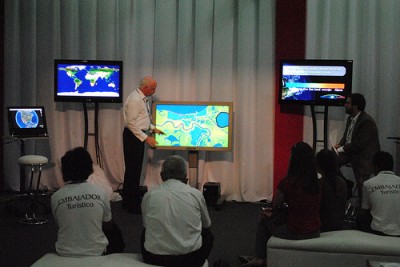ARM Data Featured at United Nations Climate Change Conference
Published: 19 January 2011

Along with NASA and NOAA, DOE provided information and data that were integrated into the StormCenter Communications, Inc. (SSC) Envirocast® Vision™ TouchTable system. Consisting of a center console with a plasma screen on each side to display supporting videos and animations, the system allows users to access, visualize and interact with the science data in real-time using touch screen technology and Google Earth™. People strolled into the “living room” of the U.S. Center at the conference to get coffee and relax while SSC presented various U.S. climate research topics on the touchtable to demonstrate real-time collaboration capabilities.
The engaging multimedia experience in the U.S. Center “living room” resulted in very positive feedback from the audience, including members of official delegations and non-governmental organizations. Members of the State Department indicated that the United States was presented exactly how they envisioned: a nation that cares about climate change and that is acting to learn more, while using the best science to adapt to the changes that are occurring, mitigate where possible, and offer assistance to other nations that ask for it. Based on the response to the demonstrations, additional outreach opportunities for using the tool to increase climate literacy are under consideration, such as use in science centers and museums across the nation.
The ARM Climate Research Facility is a DOE Office of Science user facility. The ARM Facility is operated by nine DOE national laboratories, including .
Keep up with the Atmospheric Observer
Updates on ARM news, events, and opportunities delivered to your inbox
ARM User Profile
ARM welcomes users from all institutions and nations. A free ARM user account is needed to access ARM data.


















